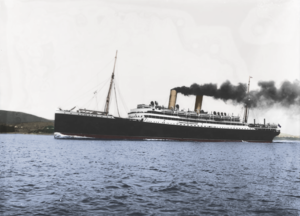 Colourised photo of Empress of Ireland
| |
| History | |
|---|---|
| Name | Empress of Ireland |
| Owner | |
| Operator | |
| Port of registry | Liverpool |
| Builder | Fairfield Shipbuilding & Eng Co, Govan |
| Yard number | 443 |
| Laid down | 10 April 1905 |
| Launched | 27 January 1906 |
| Christened | 27 January 1906 |
| Maiden voyage | 29 June 1906 |
| In service | 27 January 1906 |
| Out of service | 29 May 1914 |
| Identification |
|
| Fate | Sank after collision with SS Storstad on 29 May 1914 |
| General characteristics | |
| Type | Ocean liner |
| Tonnage | 14,191 GRT; 8,028 NRT |
| Length | 570 ft (170 m) oa; 548.9 ft (167.3 m) pp |
| Beam | 65.7 ft (20.0 m) |
| Depth | 36.7 ft (11.2 m) |
| Decks | 4 steel decks |
| Installed power | 3,168 NHP |
| Propulsion |
|
| Speed | 18 knots (33 km/h; 21 mph) |
| Capacity |
|
| Crew | 373 in 1906 |
| Designated | 2009 |
RMS Empress of Ireland was a British-built ocean liner that sank near the mouth of the Saint Lawrence River in Canada following a collision in thick fog with the Norwegian collier Storstad in the early hours of 29 May 1914. Although the ship was equipped with watertight compartments and, in the aftermath of the Titanic disaster two years earlier, carried more than enough lifeboats for all aboard, she foundered in only 14 minutes. Of the 1,477 people on board, 1,012 died, making it the worst peacetime maritime disaster in Canadian history.[1][2][3][a]
Fairfield Shipbuilding and Engineering built Empress of Ireland and her sister ship, Empress of Britain, at Govan on the Clyde in Scotland.[1] The liners were commissioned by Canadian Pacific Steamships or CPR for the North Atlantic route between Liverpool and Quebec City. The transcontinental CPR and its fleet of ocean liners constituted the company's self-proclaimed "World's Greatest Transportation System". Empress of Ireland had just begun her 96th voyage when she was lost.[4]
The wreck of Empress of Ireland lies in 40 m (130 ft) of water, making it accessible to advanced divers.[5] Many artefacts from the wreckage have been retrieved, some of which are on display in the Empress of Ireland Pavilion at the Site historique maritime de la Pointe-au-Père in Rimouski, Quebec, and at the Canadian Museum of Immigration at Pier 21 in Halifax, Nova Scotia. The Canadian government has passed legislation to protect the site.[6]

- ^ a b "Investigating the Empress of Ireland". Shipwreck Investigations at Library and Archives Canada. Library and Archives Canada. 14 February 2006. Retrieved 20 February 2018.
- ^ Cd. 7609, p. 25.
- ^ "The Empress of Ireland". Lost Ship Recovered Voyages. Royal Alberta Museum. Archived from the original on 13 March 2009. Retrieved 20 February 2018.
- ^ "The Empress of Ireland: Survivors". Lost Ship Recovered Voyages. Royal Alberta Museum. Archived from the original on 13 March 2009. Retrieved 20 February 2018.
- ^ "The Empress of Ireland: Respecting the Wreck". Lost Ship Recovered Voyages. Royal Alberta Museum. 6 February 2009. Archived from the original on 12 March 2009. Retrieved 20 February 2018.
- ^ "The Empress of Ireland: Protecting the Empress". Lost Ship Recovered Voyages. Royal Alberta Museum. 6 February 2009. Archived from the original on 12 March 2009. Retrieved 20 February 2018.
Cite error: There are <ref group=lower-alpha> tags or {{efn}} templates on this page, but the references will not show without a {{reflist|group=lower-alpha}} template or {{notelist}} template (see the help page).